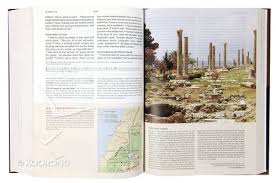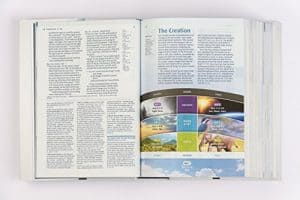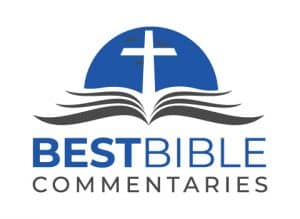Wanting to understand the Bible better is the desire of every true Christian, so there is nothing more frustrating that reading a verse, passage, or chapter of Scripture and having no idea what it means.
Like a key that unlocks a door, Study Bibles give readers access to vast amounts of historical, theological, archaeological, and literary information that help them learn God’s Word and apply it to their lives.

What exactly is a Study Bible?
Study Bibles contain notes, articles, and illustrations to help readers understand Scripture. Some Study Bibles have notes on the bottom of every page and include commentary on almost every verse, while others have notes on select verses.
Other Study Bibles include full-length articles on topics such as important archaeological discoveries, biographies on important men and women in the Bible, or explanations about Christian theology and doctrine.
A significant advantage of Study Bibles over other reference books is that all of the information is found in one place and is literally at the fingertips of readers.
See Study Bible Comparison Chart to compare and contrast dozens of options in one place.
How to choose the right Study Bible
Because Study Bibles have been proven to be useful and effective resources, literally dozens of them have been published in recent years. So how does a person choose the right one for them?
There is no one right approach because readers have different needs and Study Bibles have different purposes. Yet most people find, after doing a little research, that there is a Study Bible that meets their needs.
For example, a man may want a Study Bible with notes about being a good husband and father and a woman may want one that is focused on being a wife and mother. See Best Study Bibles for Men to see options.
Those interested in history may want a Study Bible with articles about Egypt, Greece, and Rome. Visual learners may prefer one that contains lots of full-color in-text maps, charts, diagrams, and tables. There are numerous choices. See the Study Bible Comparison Chart to compare dozens of volumes.
In summary, the best way to choose a Study Bible is:
- Pick your preferred English translation
- Identify which theme you want
- Select from among the different formats in which Study Bible are published
Below is a step-by-step approach to help you select the right one. It may best to read through this guide then browse the Bible Study Comparison Chart to identify which one is best for your needs.
Also see the Best Study Bibles for Beginners for more options.
Choosing an English translation
The Bible was originally written in Hebrew, Aramaic, and Greek. Bible translations take different approaches to interpreting these languages into English.
For example, some translations prefer to use traditional English words (e.g. thee), while others prefer to use modern English words (e.g. you).
Some translations attempt to stick as close to the original languages as possible, which sometimes results in awkward English phrasing, while others smooth out the translations to make it easier on the reader.
There are more than 60 English Bible translations today, each of which fits in one of three categories: literal translations, thought-for-thought translations, and paraphrased editions. [1, 2]
(1) Literal translations provide a close word-for-word rendering. Widely-used literal translations include:
- King James version (KJV); uses traditional English
- New King James Version (NKJV); uses modern English
- New American Standard Bible (NASB); uses modern English
- English Standard Version (ESV); uses modern English
- Holman Christian Standard Bible (HCSB); uses modern English
- New Revised Standard Version (NRSV); uses modern English
(2) Thought-for-thought translations should not be considered inaccurate in relation to word-for-word translations; rather, they aim to translate Scripture meaning-for-meaning. Wisely-used thought-for-thought translations include:
- New International Version (NIV); uses modern English
- New Living Translation (NLT); uses modern English
- New Jerusalem Bible; uses modern English
(3) Paraphrase Bibles aren’t considered “translations” by most people, because their English text is too far removed from the original languages of Scripture. Instead, authors of paraphrased bibles intend to provide the same big-picture idea to readers and use present-day terms and sayings to do so. An example of a widely-used paraphrase is:
- The Message; uses modern English
- The Living Bible; uses modern English
The five most popular English translation today are the KJV (55%), the NIV (19%), the NRSV (7%), and New American Bible (Catholic, 6%), and The Living Bible (5%). [3] Some people choose to read the same version their pastor uses while preaching because of the consistency it provides in their learning.
Many people who are new to Bible reading prefer thought-for-thought translations because the English reads more smoothly. After getting used to reading Scripture, some people may move to a word-for-word rendering if they grow in their desire for more precision. Often, people will find a favorite translation and not move to another one.
Also see Take Your Study Bible to Church: 5 Reasons It’s a Great Idea.
Reading level: Another detail to consider is reading level. Conventionally, literal translations read at the 10th to 12th grade level. Thought-for-thought translations read at the 7th to 9th grade level. Paraphrase editions read at the 6th grade level and lower. [4]
If someone is new to the Bible and is not a reader, a literal translation may not be best. However, if someone is learning to read, such as a child, a literal translation may not be best either. It may be beneficial to ask your pastor for a translation recommendation or a friend you know already has a consistent habit of Bible reading.

Choosing a Study Bible theme
The “theme” of a Study Bible refers to the topical focus of the notes, articles, and illustrations. To be clear, themes don’t affect the translation of Scripture itself.
The NIV translation, for example, remains the same whether it’s paired with a prophecy-focused Study Bible or a marriage-focused Study Bible. Themes determine the subject matter of the commentary and illustrations only. Below you will find summaries of the most well-liked Study Bible topics.
Popular Study Bible themes
Men’s and Women’s Study Bibles: There are Study Bibles for men, written by men, which focus on issues and topics related to men. Topics often include work, sex, money, and parenting.
There are also Study Bibles for women, written by women, which focus on issues and topics related to women. Articles and notes may include similar topics to the men’s Study Bible, yet oriented to women, but other articles would be unique.
There are also Study Bibles themes for teens and children.
Life Application: Application-focused Study Bibles help readers bridge the gap from the ancient biblical world to the modern world to help people live out their faith. Notes and articles answer the question, “But what does this have to do with me?”
Men’s and Women’s Study Bibles are considered a type of life-application Bibles, however application-focused themes tend to be much broader than gender, marriage, and family issues.
Because there is only so much space for comments in Study Bibles, application-focused themes generally don’t have much commentary on historical, literary, or theological topics.
History: Some Study Bibles have themes that provide detailed information about history. An example of a history-themed Study Bible is one that focuses on archaeology.
The illustrations often include pictures of artifacts like ancient statues and writing scrolls, all of which help the reader understand the cultural background of the Old and New Testament.
Other historical themes focus on life in the first century and others on Christian history. History-themed Study Bibles tend to spend less time discussing application.
Theology: Other Study Bibles focus on doctrine. Notes and articles may be about the Trinity, the Holy Spirit, spiritual warfare, or the end times. The comments in this type of study theme distill the history, literary, and linguistic teaching of Scripture and present the theological implications to the reader.
There is often significant discussion on historical matters in theology-themed Study Bibles, because there have been many important theologians in Christian history that have helped people better understand doctrine.
Apologetics: One kind of theology-themed Study Bible contains apologetics-focused commentary. Study Bibles that emphasize apologetics (from the Greek word “apology,” meaning “to provide a defense”) contain notes and articles that help readers defend their beliefs and values by using logical arguments and relevant facts.
Examples of topics include creationism, the reliability of the New Testament manuscripts, and the facts of the resurrection of Christ.
Also see the Best ESV Study Bibles to learn more.
Denominations: Some Christian denominations have study bibles to help readers understand their interpretations and perspectives. There are Reformed Study Bibles, Lutheran Study Bibles, and more.
The comment sections often provide general information on history, literature, and theology, but additionally teach about how their branch of Christianity understands certain passages and doctrines.
Pastors: Some well-known pastors also publish Study Bibles, which contain notes from their teachings, books, and sermons. Pastors like John MacArthur, Joyce Meyer, Chuck Swindoll, and Charles Stanley have published best-selling Study Bible.
The commentary notes tends to focus on application in this kind of Study Bible, and spends less time on topics like archaeology and cultural backgrounds.
General information: Some Study Bibles include notes on whatever helps the readers understand a verse or passage. Comments may be about history, theology, literature, or other topics, whatever subject helps the reader understand. Study Bibles that include general information discuss many topics, but aren’t as in depth as those that have one specific focus.
Also see the Best Study Bibles for Couples to learn more.
It’s common for readers to have more than one Study Bible on their shelf. When reading for devotional purposes, a person may select a Study Bible that helps them with application. But when preparing to lead a Bible Study, a person may select to prepare with a historical or theological Study Bible.
Additionally, some who follow annual Bible reading plans, in order to increase their knowledge of the bible holistically, may alternate what Study Bibles they use from year to year.
One year a person may want to reflect on marital topics and so they would read from a marriage-themed articles and notes.
The next year, however, the person may feel led to do more evangelism and opt for following a Bible reading plan with an apologetics Study Bible. Study Bible provide many options for readers to learn and grow.
Choosing a Study Bible format
Like most books today, Study Bibles come in hardback, paperback, and digital formats. Like most Bibles today, Study Bibles also come in leather-bound editions.
Leather-bound and hardback editions often last a long time, however they are more expensive, too, so readers must decide what their particular priority is.
When it comes to digital versions, it’s important to know if the book is formatted correctly for a specific e-reader, like Kindle. When digital books aren’t formatted correctly, the text and illustrations can be out of alignment, making bible reading frustrating.
One great place to check to see if there are formatting issues is in the reader-reviews section of a product’s buy page. People will often make comments if the formatting is off, to warn caution them about making a purchase until the problems are fixed.
Many, but not all, Study Bibles come in large print to help readers will sensitive eyesight. Smaller font sizes, such as 7 and 8, many be challenging for readers with good eyes. Larger font sizes, such as 9 and 10, may be easier to read. Then again, a good pair of glasses will solve many font issues.
Study Bibles can also be heavier than other bibles because the notes and articles add more pages to the book. Some Study Bibles contain over 200 additional pages due to the commentary. The weight of a Study Bible may be important to consider if it’s carried often in a purse or if needs to fit inside a favorite bible cover.
Also see Best Study Bibles for Pastors for more options.
Reading God’s Word
Psalm 119:105 reads, “Your word is a lamp to my feet and a light to my path” (ESV). Christians believe that the Bible reveals God’s words to humankind, which makes comprehending the Old and New Testament the longing of every genuine son and daughter of God.
Study Bibles help readers understand Scripture, making them a worthwhile investment. After all, what is more important than understanding God’s message to humankind?
References:
